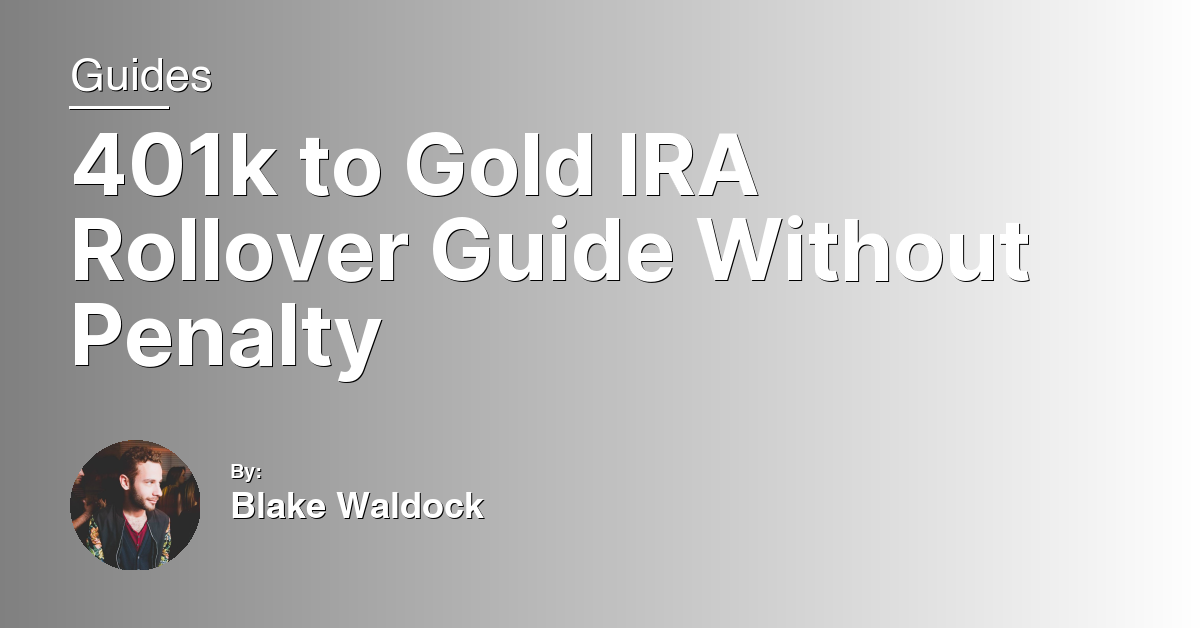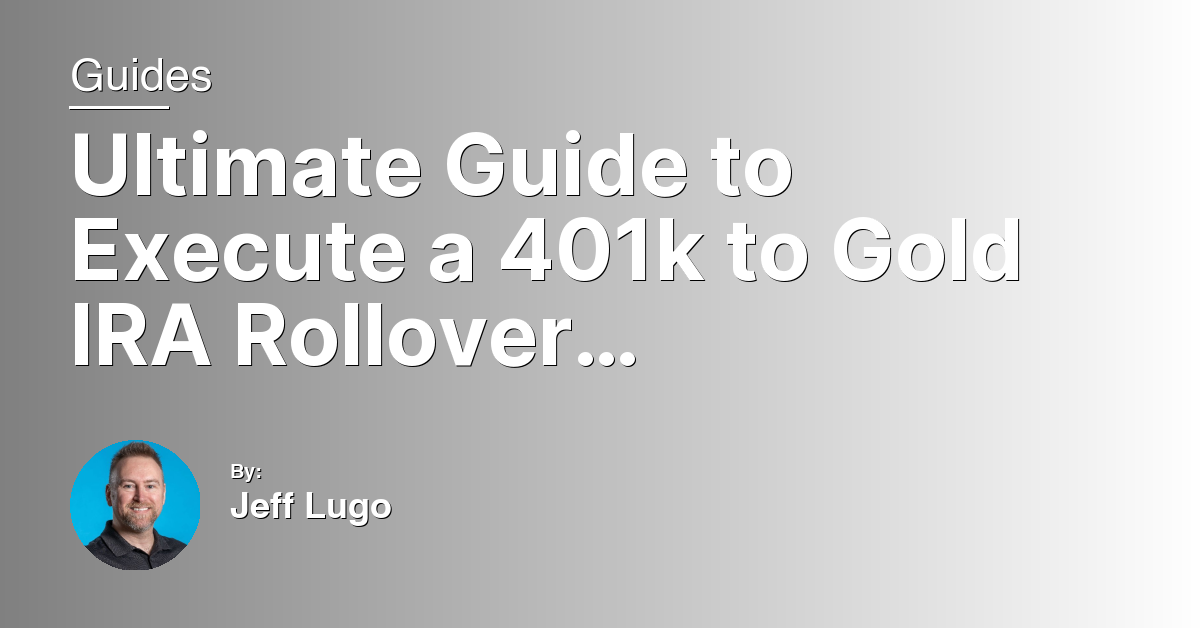In an ever-fluctuating financial landscape, diversifying one’s retirement portfolio can be a beacon of stability and security. This comprehensive guide will navigate you through the seamless process of transferring your 401(k) into a Gold IRA, ensuring your hard-earned savings not only endure but thrive in the face of economic uncertainties. Embark on this journey to safeguard your future with a step-by-step walkthrough that demystifies the rollover process, making your transition to a gold-backed retirement both smooth and rewarding.
Understanding the Basics of a Gold IRA
A Gold IRA is a specialized Individual Retirement Account (IRA) that allows investors to hold gold as a qualified investment. Unlike traditional IRAs that are typically limited to stocks, bonds, and mutual funds, a Gold IRA offers a way to diversify one’s retirement portfolio by including precious metals, which can serve as a hedge against inflation and currency devaluation.
This type of account operates under the same general tax rules as other IRAs, providing the benefit of tax deferral or, in the case of a Roth IRA, tax exemption on the growth of the investment. However, it requires setting up a self-directed IRA, which gives the investor more control over the investment choices, including the option to invest in physical gold bullion, coins, and other approved precious metal products.
Investing in gold through an IRA can be a strategic move to protect and grow your retirement nest egg, especially during times of economic uncertainty or high market volatility, as was seen during the 2007–2008 financial crisis. Gold’s intrinsic value and low correlation with other financial assets make it an attractive alternative investment for those looking to reduce risk in their retirement portfolio.
Step-by-Step Guide to Executing a Rollover

1. Determine Eligibility: Check if your current 401(k) plan allows for a rollover to a self-directed IRA, specifically for investments in gold or other precious metals. This is crucial for diversifying your portfolio and hedging against inflation.
2. Choose a Custodian: Select a reputable custodian specialized in self-directed IRAs that permit gold investments. Ensure they comply with the Internal Revenue Service (IRS) regulations to maintain tax advantages.
3. Open a Self-Directed IRA: Complete the application process with your chosen custodian. This will be the vehicle for your gold IRA rollover, offering a broader range of investment options beyond stocks and bonds, including bullion and coins.
4. Request a Rollover: Contact the administrator of your 401(k) plan to initiate the rollover. You’ll typically have two options: a direct rollover, where funds are transferred directly to your new IRA, or an indirect rollover, where the funds are sent to you and then you deposit them into your IRA. Opt for a direct rollover to avoid taxes and potential penalties.
5. Select Your Gold Investments: Once the funds are in your new IRA, work with your custodian to purchase gold or other precious metals. Aim for diversification within your precious metals portfolio to mitigate risk.
6. Monitor and Adjust: Regularly review your gold IRA’s performance. Keep an eye on market trends, the price of gold, and adjust your investments accordingly to protect your purchasing power and ensure your retirement nest egg is secure against currency devaluation and volatility.
Choosing the Right Gold and Custodian
Selecting a custodian experienced in precious metals is equally important. This entity will handle the purchase, sale, and storage of your gold, providing a secure and compliant environment for your retirement assets. Ensure the custodian is reputable, understands the nuances of gold investment, and offers transparent pricing without hidden fees.
IRS Regulations and Compliance
When rolling over a 401(k) to a Gold IRA, understanding IRS regulations is crucial to ensure compliance and maximize tax advantages. The IRS permits the inclusion of gold and other precious metals in an IRA as they recognize these assets for their potential to diversify a portfolio and hedge against inflation and currency devaluation.
To comply, the gold must meet specific purity standards (0.995 or higher) and be stored in an IRS-approved depository. Direct rollovers from a 401(k) to a Gold IRA are preferred to avoid potential taxes and penalties. This process involves transferring funds directly from your 401(k) plan to the Gold IRA without taking personal possession of the assets.
This method not only maintains the tax-deferred status of your retirement savings but also ensures you’re not subject to early withdrawal penalties. Adhering to these regulations helps safeguard your investment and leverage precious metals’ intrinsic value to protect your purchasing power over time.
Full vs. Partial Rollovers: Making the Right Choice
When deciding between full or partial rollovers for your 401(k) into a Gold IRA, understanding the implications is crucial. A full rollover means transferring all your existing retirement funds into a Gold IRA, which could be advantageous for those seeking to maximize the diversification benefits of gold and other precious metals. This approach might appeal to those aiming to hedge against inflation and the volatility of fiat money, particularly in the face of economic uncertainties like the 2007–2008 financial crisis.
On the other hand, a partial rollover allows you to move only a portion of your retirement savings into a Gold IRA, keeping the rest in your existing 401(k) or other retirement accounts. This strategy could be beneficial for maintaining a balanced portfolio that includes stocks, bonds, and alternative investments, offering a blend of growth potential, income, and a hedge against economic downturns.
The choice between full and partial rollovers should be informed by your investment goals, risk tolerance, and the desire for diversification or specialization in your retirement portfolio. Both options have tax advantages, with potential for tax deferral or tax exemption on certain gains, but it’s important to consult with a financial advisor or the Internal Revenue Service for guidance tailored to your specific situation.
Direct Trustee-to-Trustee Transfers Explained
Direct Trustee-to-Trustee Transfers are a seamless method for moving funds from your 401(k) to a Gold IRA, without the funds passing directly through you. This process ensures that your investment in precious metals is not only tax-efficient but also simplifies the transition, maintaining the tax-advantaged status of your retirement savings.
By opting for this transfer, you avoid potential taxes and penalties associated with early withdrawals from your pension or 401(k). It’s a direct movement of assets between custodians, ensuring your portfolio diversification into gold and other precious metals is executed without hitch.
This strategy is advantageous for those looking to hedge against the volatility of the stock market, fiat money, and inflation, while potentially enhancing the intrinsic value of their retirement portfolio. It’s a crucial step for investors aiming to balance their retirement savings with an alternative investment that has a historical track record of preserving wealth amidst economic uncertainties.
Common Misconceptions and Challenges Addressed
A common misconception about a Gold IRA rollover from a 401(k) is that it’s complex and fraught with tax penalties. However, when done correctly, the process is straightforward and can offer significant tax advantages. It’s crucial to understand that rolling over your 401(k) into a Gold IRA doesn’t mean withdrawing your funds but transferring them, thus avoiding early withdrawal penalties.
Another challenge is the fear of losing the diversification of a traditional 401(k) plan. Yet, incorporating gold into your retirement portfolio can actually enhance diversification. Gold often has a low correlation with stocks and bonds, making it a valuable hedge against market volatility and inflation.
Investors also worry about the intrinsic value and price fluctuations of gold. It’s important to recognize that gold has maintained its value over centuries, offering a form of financial insurance and a store of value that paper assets cannot match.
Liquidity Considerations and Solutions
When considering a Gold IRA rollover from a 401(k), liquidity is a critical factor. Gold, as a physical asset, differs significantly from stocks or bonds in terms of how quickly it can be converted into cash. This is essential for those who may need to access funds in a pinch or are planning for short-term financial goals.
To address liquidity concerns, investors should balance their portfolio with a mix of gold and more liquid assets. Diversification is key, not just across different metals but also including stocks, bonds, and other financial instruments. This strategy ensures that you can benefit from gold’s stability and hedge against inflation, while still maintaining access to assets that can be quickly liquidated if necessary.
Additionally, choosing a Gold IRA provider that offers a streamlined process for buying and selling gold can improve liquidity. Some providers offer programs that allow for quick conversion of gold holdings back to cash or into other retirement assets, mitigating the typical liquidity challenges associated with precious metal investments.
Timing Your Investment: When to Rollover
Timing your investment for a Gold IRA rollover involves strategic planning to maximize benefits and minimize risks. The ideal timing can hinge on several factors, including market conditions, your current financial situation, and future economic outlook.
First, consider the performance of the stock market and the state of the economy. Historically, gold has been a hedge against market volatility and a declining United States dollar, making it a valuable diversification tool for your investment portfolio. When stock market volatility is high or the economic outlook is uncertain, it may be a prudent time to rollover a portion of your 401(k) or pension into a Gold IRA.
Evaluate your current financial standing and retirement goals. If you’re seeking a vehicle to preserve wealth with a tax advantage, while potentially earning income, a Gold IRA offers an attractive option. It’s critical to assess your tolerance for risk, investment timeline, and the need for diversification in assets beyond stocks and bonds, including considering gold’s intrinsic value.
Lastly, keep an eye on gold’s market price and economic indicators suggesting inflation or currency devaluation. These are opportune moments to initiate a rollover, leveraging gold’s potential as a stable saving and fixed income option amidst financial uncertainty.
Avoiding Penalties and Taxes on Rollovers
To avoid penalties and taxes on rollovers from a 401(k) to a Gold IRA, it’s crucial to execute a direct rollover. This means the funds transfer directly from your 401(k) plan to the Gold IRA without you taking possession of the funds. By doing this, you circumvent the mandatory 20% withholding tax for indirect rollovers and any potential early withdrawal penalties.
Ensure your Gold IRA qualifies under the IRS guidelines to maintain the tax-advantaged status of your retirement savings. This move not only preserves your assets but also leverages gold’s intrinsic value as a hedge against inflation and dollar volatility, enhancing your portfolio’s diversification.
Evaluating Gold IRA Providers and Custodians
| Provider/Custodian | Minimum Investment | Fees | Storage Options | Customer Reviews |
|---|---|---|---|---|
| Goldco | $25,000 | Flat annual fee | Segregated storage | 4.5/5 stars |
| Birch Gold Group | $10,000 | Flat annual fee | Segregated storage | 4/5 stars |
| Noble Gold | $10,000 | Flat annual fee | Segregated storage | 4.2/5 stars |
| Advantage Gold | $25,000 | Flat annual fee | Segregated storage | 4.3/5 stars |
F.A.Qs
How do I convert my IRA to gold without penalty?
To convert your IRA to gold without penalty, you should start by choosing a reputable Gold IRA Company. Then, open a Self-Directed IRA and initiate the rollover process. Finally, purchase physical gold to complete the conversion.
What are the cons of a gold IRA?
The cons of a gold IRA include mandatory distributions starting at age 73 and the difficulty of selling physical precious metals quickly and at fair market prices.
How to open a gold IRA tax and penalty free?
To open a gold IRA tax and penalty free, you can initiate a direct rollover from your 401(k) to your new gold IRA. This involves a direct transfer of funds without any taxes being withheld or penalties incurred.

